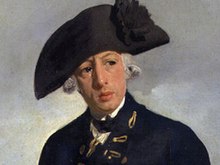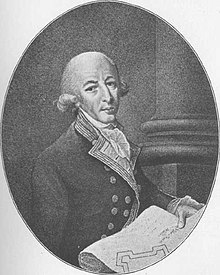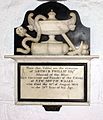Arthur Phillip
Arthur Phillip | |
|---|---|
 1786 portrait by Francis Wheatley (National Portrait Gallery, London) | |
| 1st Governor of New South Wales | |
| In office 7 February 1788 – 11 September 1795 | |
| Succeeded by | John Hunter |
| Personal details | |
| Born | 200px 11 October 1738 London, England |
| Died | 31 August 1814 (aged 75) Bath, England |
| Resting place | 200px |
| Parent |
|
| Military service | |
| Allegiance | |
| Branch/service | Royal Navy |
| Rank | Admiral |
| Battles/wars | Seven Years' War Spanish-Portuguese War American Revolutionary War |
Admiral Arthur Phillip RN (11 October 1738 – 31 August 1814) was a British admiral and colonial administrator. Phillip was appointed Governor of New South Wales, the first European colony on the Australian continent,[1] and was the founder of the settlement which is now the city of Sydney.[2]
Early life and naval career
Arthur Phillip was born in 1738, the son of Jacob Phillip, a Frankfurt-born language teacher, and his English wife, Elizabeth Breach, who had remarried after the death of her previous husband, a Captain Herbert, R.N., a collateral descendant of the noble family of Herbert, Earl of Pembroke[3].
Phillip was educated at the Greenwich Hospital School, part of Greenwich Hospital, and at the age of 13 was apprenticed to the merchant navy.
Seven Years' War
Phillip joined the Royal Navy at about fifteen, and saw action at the outbreak of the Seven Years' War in the Mediterranean at the Battle of Minorca in 1756. In 1762 he was promoted to Lieutenant, but was placed on half pay when the Seven Years' War ended in 1763. During this period he married, and farmed in Lyndhurst, Hampshire.
In 1774 Phillip joined the Portuguese Navy as a captain, serving in the War against Spain. While with the Portuguese Navy, Phillip commanded a frigate, the Nossa Senhora do Pilar. On this ship he took a detachment of troops from Rio de Janeiro to Colonia do Sacramento on the Rio de la Plata (opposite Buenos Aires) to relieve the garrison there; this voyage also conveyed a consignment of convicts assigned to carry out work at Colonia. During a storm encountered in the course of the voyage, the convicts assisted in working the ship and, on arrival at Colonia, Phillip recommended that they be rewarded for saving the ship by remission of their sentences.[4] A garbled version of this eventually found its way into the English press when Phillip was appointed in 1786 to lead the expedition to Sydney.[5]
In 1778 Britain was again at war, and Phillip was recalled to active service, and in 1779 obtained his first command, HMS Basilisk. He was promoted to captain in 1781, and was given command of HMS Europe, but in 1784 he was back on half pay.[6]
Governor of New South Wales
This section needs additional citations for verification. (January 2011) |
In October 1786, Phillip was appointed captain of HMS Sirius and named Governor-designate of New South Wales, the proposed British penal colony on the east coast of Australia, by Lord Sydney, the Home Secretary. His choice may have been strongly influenced by George Rose, Under-Secretary of the Treasury and a neighbour of Phillip in Hampshire who would have known of Phillip's farming experience.
Phillip had a very difficult time assembling the fleet which was to make the eight-month sea voyage to Australia. Everything a new colony might need had to be taken, since Phillip had no real idea of what he might find when he got there. There were few funds available for equipping the expedition. His suggestion that people with experience in farming, building and crafts be included was rejected. Most of the 772 convicts (of whom 732 survived the voyage) were petty thieves from the London slums. Phillip was accompanied by a contingent of marines and a handful of other officers who were to administer the colony.
The First Fleet, of 11 ships, set sail on 13 May 1787. Captain Arthur Phillip collected a number of Cochineal-infested plants from Brazil on his way to establish the first British settlement at Botany Bay.[7] The leading ship, HMS Supply reached Botany Bay setting up camp on the Kurnell Peninsula,[8] on 18 January 1788. Phillip soon decided that this site, chosen on the recommendation of Sir Joseph Banks, who had accompanied James Cook in 1770, was not suitable, since it had poor soil, no secure anchorage and no reliable water source. After some exploration Phillip decided to go on to Port Jackson, and on 26 January the marines and convicts were landed at Sydney Cove, which Phillip named after Lord Sydney.
Shortly after establishing the settlement at Port Jackson, on 15 February 1788, Phillip sent Lieutenant Philip Gidley King with 8 free men and a number of convicts to establish the second British colony in the Pacific at Norfolk Island. This was partly in response to a perceived threat of losing Norfolk Island to the French and partly to establish an alternative food source for the new colony.
The early days of the settlement were chaotic and difficult. With limited supplies, the cultivation of food was imperative, but the soils around Sydney were poor, the climate was unfamiliar, and moreover very few of the convicts had any knowledge of agriculture. Farming tools were scarce and the convicts were unwilling farm labourers. The colony was on the verge of outright starvation for an extended period. The marines, poorly disciplined themselves in many cases, were not interested in convict discipline. Almost at once, therefore, Phillip had to appoint overseers from among the ranks of the convicts to get the others working. This was the beginning of the process of convict emancipation which was to culminate in the reforms of Lachlan Macquarie after 1811.
Phillip showed in other ways that he recognised that New South Wales could not be run simply as a prison camp. Lord Sydney, often criticised as an ineffectual incompetent, had made one fundamental decision about the settlement that was to influence it from the start. Instead of just establishing it as a military prison, he provided for a civil administration, with courts of law. Two convicts, Henry and Susannah Kable, sought to sue Duncan Sinclair, the captain of Alexander, for stealing their possessions during the voyage. Convicts in Britain had no right to sue, and Sinclair had boasted that he could not be sued by them. Someone in Government obviously had a quiet word in Kable's ear, as when the court met and Sinclair challenged the prosecution on the ground that the Kables were felons, the court required him to prove it. As all the convict records had been left behind in England, he could not do so, and the court ordered the captain to make restitution. Further, soon after Lord Sydney appointed him governor of New South Wales Arthur Phillip drew up a detailed memorandum of his plans for the proposed new colony. In one paragraph he wrote: "The laws of this country [England] will of course, be introduced in [New] South Wales, and there is one that I would wish to take place from the moment his Majesty's forces take possession of the country: That there can be no slavery in a free land, and consequently no slaves",[9] and he meant what he said. Nevertheless, Phillip believed in discipline, and floggings and hangings were commonplace, although Philip commuted many death sentences.

Phillip also had to adopt a policy towards the Eora Aboriginal people, who lived around the waters of Sydney Harbour. Phillip ordered that they must be well-treated, and that anyone killing Aboriginal people would be hanged. Phillip befriended an Eora man called Bennelong, and later took him to England. On the beach at Manly, a misunderstanding arose and Phillip was speared in the shoulder: but he ordered his men not to retaliate. Phillip went some way towards winning the trust of the Eora, although the settlers were at all times treated extremely warily. Soon, smallpox and other European-introduced epidemics ravaged the Eora population.
The Governor's main problem was with his own military officers, who wanted large grants of land, which Phillip had not been authorised to grant. The officers were expected to grow food, but they considered this beneath them. As a result scurvy broke out, and in October 1788 Phillip had to send Sirius to Cape Town for supplies, and strict rationing was introduced, with thefts of food punished by hanging. Arthur Phillip quoted "The living conditions need to improve or my men won't work as hard, so I have come to a conclusion that I must hire surgeons to fix the convicts."
Stabilising the colony
By 1790 the situation had stabilised. The population of about 2,000 was adequately housed and fresh food was being grown. Phillip assigned a convict, James Ruse, land at Rose Hill (now Parramatta) to establish proper farming, and when Ruse succeeded he received the first land grant in the colony. Other convicts followed his example. Sirius was wrecked in March 1790 at the satellite settlement of Norfolk Island, depriving Phillip of vital supplies. In June 1790 the Second Fleet arrived with hundreds more convicts, most of them too sick to work.

By December 1790 Phillip was ready to return to England, but the colony had largely been forgotten in London and no instructions reached him, so he carried on. In 1791 he was advised that the government would send out two convoys of convicts annually, plus adequate supplies. But July, when the vessels of the Third Fleet began to arrive, with 2,000 more convicts, food again ran short, and he had to send a ship to Calcutta for supplies.
By 1792 the colony was well established, though Sydney remained an unplanned huddle of wooden huts and tents. The whaling industry was established, ships were visiting Sydney to trade, and convicts whose sentences had expired were taking up farming. John Macarthur and other officers were importing sheep and beginning to grow wool. The colony was still very short of skilled farmers, craftsmen and tradesmen, and the convicts continued to work as little as possible, even though they were working mainly to grow their own food.
In late 1792 Phillip, whose health was suffering from the poor diet, at last received permission to leave, and on 11 December 1792 he sailed in the ship Atlantic, taking with him many specimens of plants and animals. He also took Bennelong and his friend Yemmerrawanyea, another young Indigenous Australian who, unlike Bennelong, would succumb to English weather and disease and not live to make the journey home. The European population of New South Wales at his departure was 4,221, of whom 3,099 were convicts. The early years of the colony had been years of struggle and hardship, but the worst was over, and there were no further famines in New South Wales. Phillip arrived in London in May 1793. He tendered his formal resignation and was granted a pension of £500 a year.
Later life
Phillip's wife, Margaret, had died in 1792. In 1794 he married Isabella Whitehead, and lived for a time at Bath. His health gradually recovered and in 1796 he went back to sea, holding a series of commands and responsible posts in the wars against the French. In January 1799 he became a Rear-Admiral. In 1805, aged 67, he retired from the Navy with the rank of Admiral of the Blue, and spent most of the rest of his life at Bath. He continued to correspond with friends in New South Wales and to promote the colony's interests with government officials. He died in Bath in 1814.[10]

Phillip was buried in St Nicholas's Church, Bathampton. Forgotten for many years, the grave was discovered in 1897[11] and the Premier of New South Wales, Sir Henry Parkes, had it restored. An annual service of remembrance is held here around Phillip's birthdate by the Britain-Australia Society to commemorate his life. A monument to Phillip in Bath Abbey Church was unveiled in 1937. Another was unveiled at St Mildred's Church, Bread St, London, in 1932; that church was destroyed in the London Blitz in 1940, but the principal elements of the monument were re-erected in St Mary-le-Bow at the west end of Watling Street, near Saint Paul's Cathedral, in 1968.[12] There is a statue of him in the Botanic Gardens, Sydney. There is a portrait of him by Francis Wheatley in the National Portrait Gallery, London.
His name is commemorated in Australia by Port Phillip, Phillip Island (Victoria), Phillip Island (Norfolk Island), the federal electorate of Phillip (1949–1993), the suburb of Phillip in Canberra, and many streets, parks and schools.
Percival Serle wrote of Phillip in his Dictionary of Australian Biography:
Steadfast in mind, modest, without self seeking, Phillip had imagination enough to conceive what the settlement might become, and the common sense to realize what at the moment was possible and expedient. When almost everyone was complaining he never himself complained, when all feared disaster he could still hopefully go on with his work. He was sent out to found a convict settlement, he laid the foundations of a great dominion.[13]
Loss of remains
In 2007, Geoffrey Robertson QC alleged that Phillip's remains are no longer in St Nicholas Church, Bathampton and have been lost: "...Captain Arthur Phillip is not where the ledger stone says he is: it may be that he is buried somewhere outside, it may simply be that he is simply lost. But he is not where Australians have been led to believe that he now lies."[14] Robertson also believes it was a "disgraceful slur" on Phillip's legacy that he was not buried in one of England's great cathedrals and was relegated to a small village church. Robertson is campaigning for a rigorous search for the remains, which he believes should be re-interred in Australia.
Popular culture
Phillip is a prominent character in Timberlake Wertenbaker's play Our Country's Good, in which he commissions Lieutenant Ralph Clark to stage a production of The Recruiting Officer. He is shown as compassionate and just, but receives little support from his fellow officers.
Phillip is referred to in the John Williamson song "Chains around my ankle".
Kate Grenville's 2008 novel The Lieutenant portrays Phillip through the character Commodore James Gilbert.
Gallery
-
The Arthur Phillip memorial on the wall of the Australia Chapel, Bathampton
-
Bathampton Memorials
-
Bust of Phillip at St Mary's
See also
References
- ^ Phillip of Australia, Barnard Eldershaw, M. Angus and Robertson 1938
- ^ Samuel Eliot Morison (22 May 1944). "The Gilberts & Marshalls: A distinguished historian recalls the past of two recently captured pacific groups". Life magazine. Retrieved 14 October 2009.
- ^ Keneally, T (2005) Commonwealth of Thieves: The Improbable Birth of Australia, Vintage, London. P36
- ^ Maurine Goldston-Morris, OAM, The Life of Admiral Arthur Phillip, RN, 1738–1814, Naval Historical Society of Australia Monograph No.58, Garden Island, [1997].
- ^ See for example, The World, 16 April 1789: "BOTANY BAY.— Mr. Philip, who has this command, has the aid of experience. He had a similar expedition entrusted him by PORTUGAL, to carry convicts to South America.".
- ^ Robert J. King, "Arthur Phillip Defensor de Colónia, Governador de Nova Gales do Sul" ("Arthur Phillip: Defender of Colônia, Governor of New South Wales"), Anais de História de Além-Mar [Portugal], 2005 (6), pp.339–349. Also at: http://web.viu.ca/black/amrc/index.htm (in English and Spanish) and (in Portuguese) at: http://derroteros.perucultural.org.pe/textos/derroteros9/king.doc
- ^ http://www.northwestweeds.nsw.gov.au/prickly_pear_history.htm Prickly Pear in Australia
- ^ The Voyage of Governor Phillip to Botany Bay With an Account of the Establishment of the Colonies of Port Jackson and Norfolk Island (1789) – from Project Gutenberg
- ^ Historical Records of New South Wales, Volume 1, Part 2, Phillip 1783–1792, p 53
- ^ Broughton, W. (1 April 1815). "Sydney: Sitting Magistrate W. Broughton Esq". The Sydney Gazette and New South Wales Advertiser. G. Howe. p. 2. Retrieved 11 August 2007.
{{cite news}}: Cite has empty unknown parameter:|coauthors=(help) - ^ St Nicholas Church, Bathampton, Burial place of Arthur Phillip
- ^ Details of move
- ^ Serle, Percival (1949). "Phillip, Arthur (1738-1814), admiral, and first governor of New South Wales". Dictionary of Australian Biography. Project Gutenberg Australia. Retrieved 3 March 2011.
- ^ Lost the plot
External links
- Works by Arthur Phillip at Project Gutenberg
- Arthur Phillip High School, Parramatta – state high (years 7–12) school named for Phillip
- B. H. Fletcher, 'Phillip, Arthur (1738–1814)', Australian Dictionary of Biography, Volume 2, Melbourne University Press, 1967, pp 326–333.
- Royal Navy History Biographical Memoir of Arthur Phillip, Esq.
- Use dmy dates from April 2011
- Governors of New South Wales
- City founders
- Royal Navy admirals
- 1738 births
- 1814 deaths
- Australian penal colony administrators
- Royal Navy personnel of the Seven Years' War
- British naval personnel of the American Revolutionary War
- People from Fulham
- English people of German descent
- Port Phillip
- 19th-century Australian people
- People educated at the Royal Hospital School




